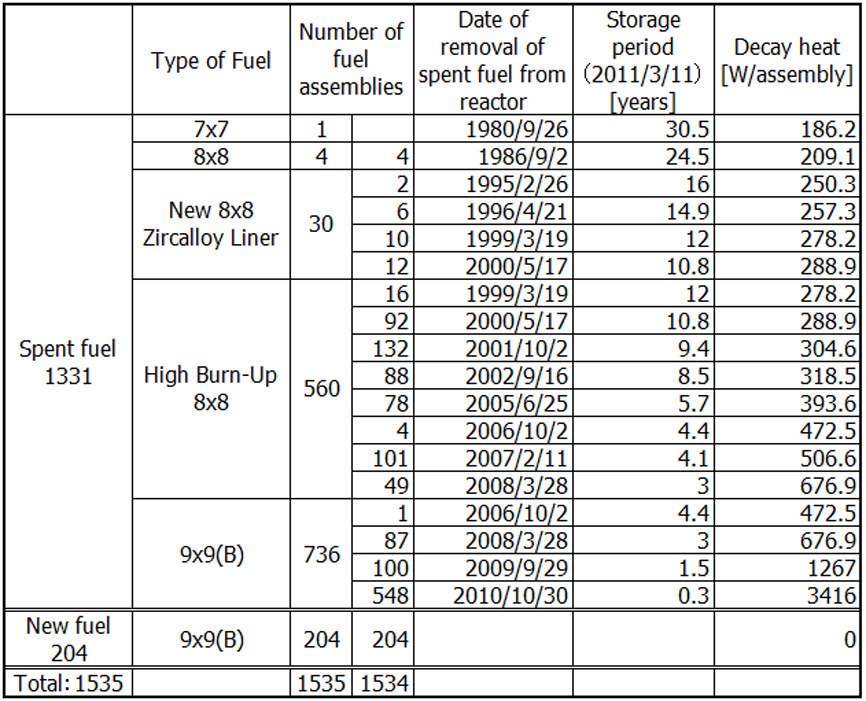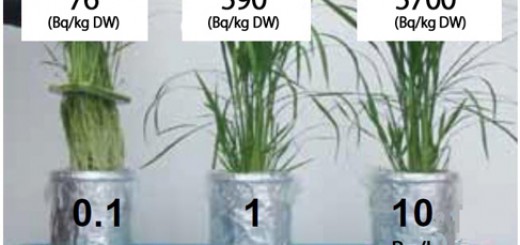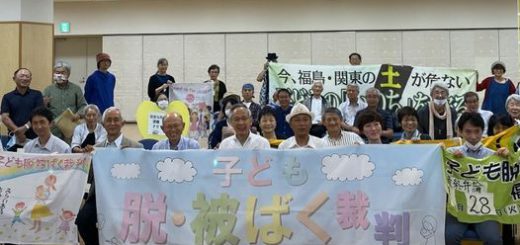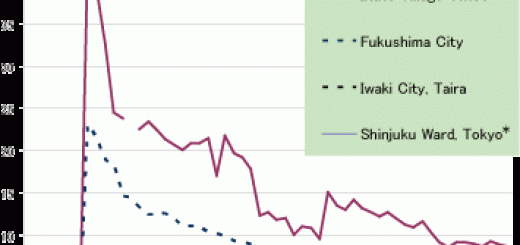The Status of Nuclear Fuel Stored at the Fukushima Daiichi and Fukushima Daini Nuclear Power Plants Nuke Info Tokyo No. 154
This report summarizes the status of nuclear fuel stored at the Fukushima Daiichi (F1) and Fukushima Daini (F2) nuclear power plants.
 |
| Table 1; Status of Nuclear Fuel Stored at the Fukushima Daiichi and Fukushima Daini Nuclear Power Plants (as of January 31, 2013) Prepared by CNIC based on data published by the Agency for Natural Resources and Energy and TEPCO(*1) Calculated value (ton) from number of fuel assemblies. (*2) Total number of fuel assemblies is 1,535, including 204 new fuel assemblies, as of March 11, 2011, since two new fuel assemblies were removed on 2012/7/18-19. (*3) Including two new fuel assemblies removed from the F1-4 spent fuel pool. (*4) All fuel assemblies in the reactor transferred to spent fuel pool in October 2012. |
Fuel in the reactors and fuel in the spent fuel pools at F1 and F2
Table 1 lists the data for the nuclear fuel loaded (melted down) in the reactors and fuel stored in the fuel pools in the individual reactor buildings of the F1 and F2 plants as of January 31, 2013. The fuel from F1 Unit 4 reactor had been entirely unloaded for shroud replacement work. The removed fuel was in the spent fuel pool (SFP), in which as many as 1,535 fuel assemblies, including new fuel assemblies, were stored, generating a great amount of heat (Table 2). All the fuel in the F2 Unit 4 reactor was unloaded and placed into the F2 Unit 4 SFP in October 2012.
F1 Unit 4 spent fuel pool
 |
| Fugure 1; Fukushima Daiichi (F1) Unit 4 Fuel Removal Cover |
 |
| Table 2; Fuel Assemblies Stored in Fukushima Daiichi (F1) Unit 4 SFP (by year of unloading) and Decay Heat (as of March 11, 2011) Prepared by CNIC based on SAND2012-6173, Fukushima Daiichi Accident Study (Status as of April 2012) and TEPCO |
Since a hydrogen explosion occurred in the upper part of the F1 Unit 4 building on March 15, 2011, a large amount of debris fell down onto the pool. There is strong concern both in Japan and overseas about the integrity of the fuel assemblies and Unit 4 building. Tokyo Electric Power Company (TEPCO) reinforced the lower part of the SFP with rigid supports and concrete walls. The company has stated repeatedly that “The pool is sufficiently quakeproof and will resist an earthquake as great as the 2011 Earthquake off the Pacific Coast of Tohoku” (intensity 6 plus). This explanation has no scientific grounds. A detailed diagram of the fuel assembly configuration in the F1 Unit 4 SFP is available on the Internet (Fig. 2).
“Fuel removal cover”
TEPCO plans to begin the work of removing fuel from the F1 Unit 4 SFP in mid-November, 2013, and to complete the work about one year later, at the end of 2014. To ensure the feasibility of the removal work, the power company transferred two new fuel assemblies from the SFP to the common pool, inspected them, and reported that they were free from corrosion and deformation. However, this is far too hasty a conclusion, since great volumes of seawater were poured into the SFP and because only two fresh fuel assemblies were inspected, not spent fuel assemblies.
Because the original fuel crane and other facilities of F1 Unit 4 were destroyed in the hydrogen explosion, TEPCO plans to transfer the fuel from the SFP after removing the fifth floor of the reactor building. All the debris will then be cleared off the SFP and a structure named a fuel removal cover will be installed next to the building. The structure is planned to stand 53 meters above ground, measure about 69 meters north–south, and about 31 meters east–west (Fig. 1). According to TEPCO, the structure of the cover supporting the crane is designed so as not to place any load on the reactor building. Nevertheless, the quake resistance of the cover will not be sufficient. It is planned to transfer the removed fuel assemblies to the common pool by means of two shipping casks (model NFT-22B), which have a capacity of up to 22 assemblies.
Common spent fuel pool
A total of 6,375 nuclear fuel assemblies are currently stored in the F1 common pool. The pool is expected to accept a total of 3,108 fuel assemblies from the SFPs of F1 Units 1 to 4 in the future. As Table 1 shows, however, the common pool has almost no extra capacity (it is about 93% full). Accordingly, about half the fuel assemblies currently in the common pool are expected to be transferred to temporary dry cask storage facilities, explained below, to provide capacity for the fuel assemblies being transferred from the SFPs. These fuel assemblies include those whose storage is not included in the construction permit of the common pool, such as spent fuel (7×7 fuel assemblies), fresh fuel (9×9 fuel assemblies), and damaged fuel, as well as almost all the variations of boiling-water reactor fuel assemblies, as shown in Table 2. The fuel assemblies being transferred from the SFPs to the common pool are assumed to be damaged or contaminated with salt, and common pool renovation is planned to maintain water quality.
Dry cask storage facilities
 |
| Fugure 2; Unit 4 Fuel Storage Configuration Reproduced from “DOE Response to Fukushima Dai-ichi Accident,” by John E. Kelly, May 26, 2011, available at pbadupws.nrc.gov/docs/ML1114/ML11147A075.pdf (page 188/210). TEPCO provided this configuration to the US Department of Energy (DOE), but to date has not published it in Japan. |
The F1 plant is equipped with a facility to store spent fuel assemblies in dry casks. A total of 408 spent fuel assemblies are stored in the facility, in four middle-sized casks (each storing 37 assemblies) and five large casks (each storing 52 assemblies). The facility is located near the ocean and is assumed to have been partially inundated in the earthquake and subsequent tsunami on March 11, 2011. The integrity of the stored fuel will be investigated at some point in the future. The facility is severely damaged inside, and the monitoring instruments, such as thermometers, and the ceiling crane are out of order. “The facility is no longer useable,” says TEPCO. The casks are due to be transferred.
Temporary dry cask storage facilities
TEPCO plans to transfer dry storage casks and spent fuel assemblies in the common pool to a new temporary dry cask storage facility which will be built on the F1 site. This facility is scheduled to hold 20 dry storage casks (a design storage period of 40 years) and 45 dual-purpose transportation and storage casks (which can store 69 fuel assemblies each and have a design storage period of 50 years). Though the facilities are for temporary storage, they will be used for a period of 50 years. Japan is not highly experienced in the dry storage of fuel, and it is a great challenge for the country to ensure the integrity of dry-stored fuel for such a long period of time.
Masako Sawai (CNIC)



